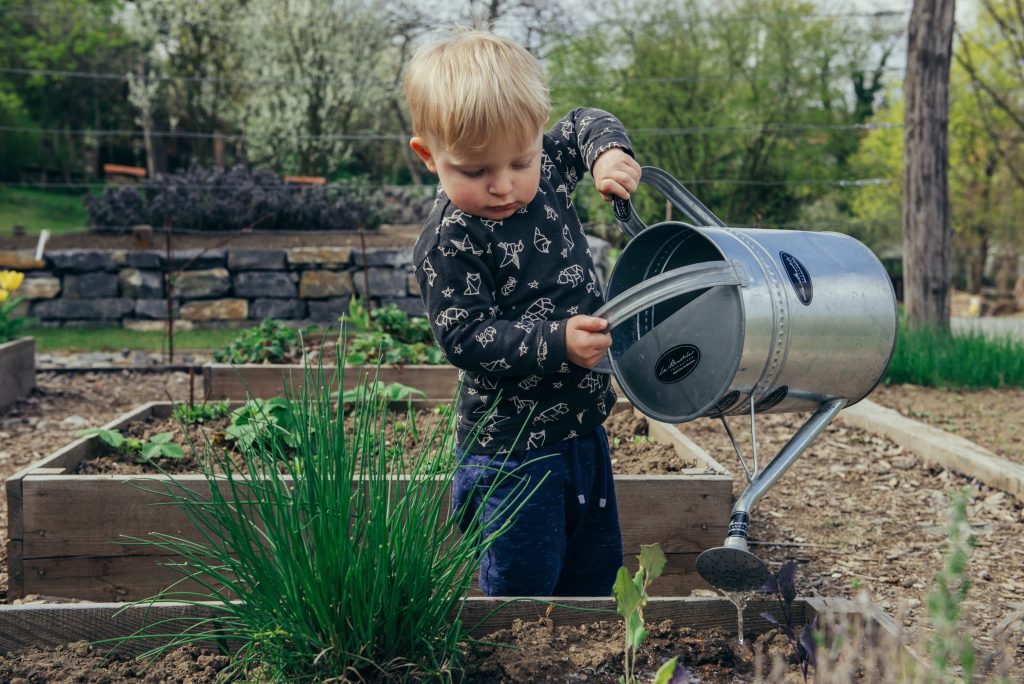Gardening with Kids

Gardening is the perfect summer activity to do with kids. It teaches responsibility and caretaking. It encourages good habits such as outdoor play and healthy eating. It shows them how plants grow and promotes environmental awareness. It exposes them to an ecosystem, providing an opportunity to highlight the importance of insects, worms, and other creatures. It develops their confidence and their patience, and best of all it creates memories of the time they share with you in the garden.
I remember gardening with my parents as a young child, my father running twine between two sticks to mark out where each row of vegetables should go, my awe at the shape and size of the different seeds, and the delight of watching the seedlings emerge.
If you are new to gardening, it can be intimidating, but it doesn’t have to be complicated. There’s no need to dedicate a large amount of space, time, or money. Start small. Plant some marigolds in a pot or buy a patio tomato plant or a container of herbs. If you want to take it a step further, create a raised bed or a small vegetable patch in a sunny spot. All you need is soil, water, sunlight, and maybe a couple of garden tools. The back of seed packages and the plastic tags in the plant pots give growing instructions. Just follow the directions and you’ll do fine!
Involve your children from the start. Ask them what they want to grow. Bring them into our greenhouse to pick out the seeds and plants. Make it fun. Go out to the garden with them every day to see if anything has come up or how fast it grows. Explain things as you go – how plants need sunlight, soil, and water to grow, that worms help make good soil, or how pollinators help plants grow. When it’s time, let them pick what they’ve grown and take pride in it. Make a celebratory meal or snack from their vegetables or display a vase of their flowers in the house.
 Here are some ideas of what to grow:
Here are some ideas of what to grow:
• Veggies they love to eat (and maybe one that they don’t). Most children take a greater interest in growing the food they like. I think most of us adults do, too. The inverse is true too, they will take more of an interest in eating what they grew (wink, wink)!
• Plants that are easy to grow and care for. Try carrots, zucchini, lettuce, beans, pumpkins, zinnia, nasturtium, marigolds, petunias, and impatiens.
• Plants that germinate or grow quickly. Radishes, lettuce, kale cucumbers, and watermelon come up quickly as do zinnias and sunflowers. It can be hard for kids to wait for seeds to germinate. Planting at least one thing that comes up within a few days keeps the excitement going. And we are all impatient to get to the good part, so be sure to plant something that matures quickly. Radishes, lettuce, and kale are fast growers, as well as peas, beets, broccoli, nasturtiums, and sunflowers.
• Things that wow with size, large or small. Pumpkins, pole beans, hollyhocks, and sunflowers are fun things that grow big. Or go tiny with grape tomatoes, bite-sized sweet peppers, or miniature carrot varieties. Create a fairy garden with small-scale decorations and low-growing plants. Ageratum, thyme, nasturtiums, low-growing sedum, hens and chicks, chives, and polka dot plants make great fairy garden choices plants.
• Things that have unusual colors like purple carrots or yellow tomatoes.
• Flowers you can eat. Nasturtiums and lavender are great choices.
• Things that appeal to senses smell and touch. Lavender, scented geraniums, thyme, and mint smell wonderful. Lamb’s ear, dusty miller, and feather grasses.
If you want to take it a step further have the kids keep a garden journal, calendar, or sketchbook or create garden markers out of rocks and paint pens. There are endless opportunities to engage kids in math, science, and art in the garden. Search for “gardening activities for kids” on the internet and see what comes up or check out a book or two from the library.
Still not sure where to start? Call us, stop in, or email or message us on Facebook with any questions. We are always happy to help. questions. We are always happy to help.
